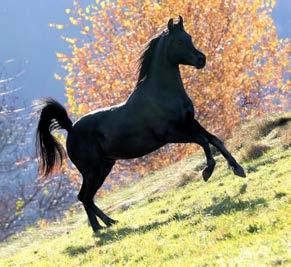
13 minute read
Al Jabal Arabians
Al Jabal Arabians in Switzerland: An Example of Preservation Breeding
Advertisement
Stallion HAR Baarez overlooking the Valley down below

The Queen of Al Jabal Arabians: the homebred Rheemah al Jabal - a Salaa El Dine granddaughter

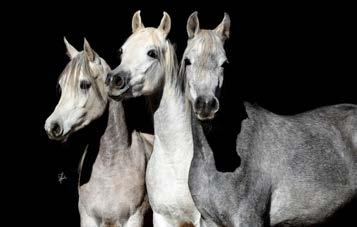
Four year old mares of Al Jabal Arabians: Masida Halima, Jumanah Al Jabal, Rayyanah Al Jabal
n text and interview Monika Savier All Photos, unless otherwise stated, by Joanna Jonientz
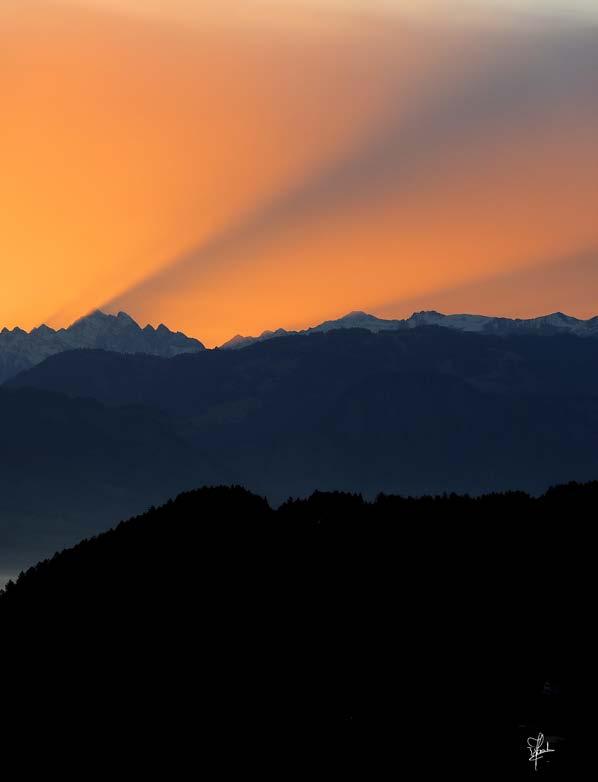
Living at almost 1000 meters above sea level, on a mountain in the Alps, is not easy. The way up there is hard going. However, once you arrived, you enjoy a good overview and know why you left the valley behind. That is about what must have gone on in the creative life of Maya Jones, a successful Swiss lady breeder and founder of Al Jabal Arabians. She was one of the first women to decide, as early as the late 1970ies, to extend her hobby, which was riding Arabian horses, into an Arabian horse breeding operation. For her, this was not about any Purebred Arabians, but about Straight Egyptians, an Arabian breeding line that is often considered closest to the original Arabians, as they may have looked in their Arabian countries of origin. At that time, Arabian shows were rare. Anybody who owned and rode Purebred Arabians would do so out of passion and as a hobby. “Al Jabal Stud offers an incredible view of the Mountains, but even better is the view inside Al Jabal Arabians’ breeding barn” Maya says with a twinkle in her eyes. We have been knowing each other for 30 years, and I very much respect her active enthusiasm for natural proceedings in breeding. Some of her horses are related to mine via their pedigrees, so it’s usually quite fascinating to talk about successes and failures with her, reflecting what happened. Among our topics, there is often the role and the difficulties that European horse breeding has been seeing since the markets got globalized. How did we benefit from that? What did we lose? Where are we today, and which strategies are useful for improving the horses without losing the positive traits and aspects of the original breed? Find here the interesting interview with Maya Jones.
Latifa by M. Groger - Al Jabal Arabians Foundation mare
Monika: When did Arabian horse breeding start for you?
Maya: I first fell in love with straight Egyptians back in 1979 - he was a son of Ibn Galal (Galal x Mohga by El Sareei) named Sher-Gall (Sherifa by Mahomed out of Marah), and he was an Abayyan stallion. He had the sweetest character and was both a lovely riding horse and a family horse. He really captured my heart with his spirit and loyalty. I was a young girl, and things changed forever the day that Sher-Gall came into my life.
Monika: How did you get to like the Straight Egyptians, and why the horses of the Abayyan Om Juray strain in particular?
Maya: I was fascinated by the history of the Egyptian Horse and decided to concentrate on breeding Abayyan straight Egyptian Arabians. I knew that there were only a few hundred breeding horses of this traditional Bedouin strain, the Abayyan Om Jurays, left in the world and I believe the horses of this line are the modern embodiment of their warhorse ancestors. They all descend from an Abayyah Um Jurays of Muhammad Ibrahim al-Hajj of Cairo, Egypt, who was purchased in 1931 by King Fuad. There are three sub-strains of the Abayyan line, most of them bred by the Shammar and Tahawi Bedouins. They are the Abayyan Seheyli, Abayyan Sherrak, and Abayyan Um Jurays, sometimes spelled Abayyan Om Grees or also called Obayan Om Grees. In the writings of the Orient experts of a few hundred years ago, there are comments about the Abayyans to be found: they were described as being similar to the Saqlawi; beautiful, elegant and showy with a high head and very good tail carriage, the legs of a racehorse and a wonderful shoulder with enormous ribcage and with great speed, agility and adequate endurance. I believe they are the original jewels of the desert. And because history has shown that the Abayyan cross well with other strains, especially the Saklawi strain, I started about ten years ago to outcross my mares with mostly Saklawi stallions. I would like to remind everybody of the three most influential broodmares of the last century who were of the Abayyan Om Jurays strain: Magidaa (Alaa el Din x Maysa by Anter), Hanan (Alaa el Din x Mona by Badr) and Marah (Galal x Maysa by Anter).
Monika: How did you finally arrive at the idea of a stud of your own with this clear-cut breeding goal?
Maya: It was my cousin’s husband Felix who introduced me to straight Egyptian Arabians. I loved all horses from the time when I was a young girl, but the moment I saw the straight Egyptians for the first time, I fell in love. Felix and I would just sit together for hours; talking about the bloodlines and putting together handwritten pedigrees, going right back to the desert-bred foundations. We would print A3 sheets and write each strain in a different colour. I became so fascinated with this, and this led to an interest in the heritage of the straight Egyptian. I guess it almost became an obsession, analysing pedigrees. Professionally speaking, I studied economy (trust me, I was never able to apply that knowledge with the horses…) and added a Master of Science to my academic career. With this, I was able to travel the world as a consultant in supply chain management for a very big company. In every Country I spent time in, I would always look for Arabian Horses whenever possible. After settling down, I found this place here in the Swiss mountains, and started my straight Egyptian breeding program in earnest. I used to live in a traditional Swiss chalet until not long ago, a fire caused by a malfunctioning power cord completely destroyed my home. Luckily, me and all the animals (horses, dogs and cats) survived with no injuries, but I lost all my material things. As I had always desired to live closer to my horses anyway, I placed a mobile home right on the paddock to live in until the new house will be built.
Monika: After this dramatic and existential experience, I can imagine the horses have become even more important to you. Tell us which horses you choose for your present breeding activities.
Maya: The mare I started with was the lovely chestnut mare, Latifa by Teymur B x Nadira V, an Ibn Nejdy granddaughter who was bred by the late Sigi Manz in Germany. At the same time as her, I was able to acquire a beautiful Salaa El Dine son in Italy, and the first daughter


Maya and her precious mare Rheemah al Jabal and her 2020 colt Rasheek al Jabal - an eight-month-old colt by Hanine al Shahania x Rheemah al Jabal
of the two was a filly named Rheemah al Jabal. Rheemah was the only filly I got out of Latifa before she died of a colic. Luckily, Rheemah turned into a beautiful fleabitten mare who is still with me and is continuing the legacy of her dam Latifa. Her get is in Switzerland, Germany, and Egypt and recently she has been awarded the label premium mare of our breeding society. Rheemah is the most motherly, loving mare that I could ever think of. She is incredibly special to me – she raised her own foal and adopted another one who had been rejected. Rheemah is this wonderful combination of intelligence, power, stamina, love, and dedication to humans and she is a great riding horse too. Rheemah has a pretty 2020 colt – Rasheek al Jabal – by the multiple champion stallion Hanine al Shahania (Al Adeed al Shaqab x Shomos al Nasser) and she is pregnant for a 2021 foal from the black pearl HAR Baarez (NK Ibn Leyl x HAR Basara – an Anaza El Farid great granddaughter). The almost four-year-old mare Jumanah al Jabal is a precious daughter of Rheemah al Jabal and my beloved stallion NK Abbas El Dins (see below). She will begin her
King of the Mountains: homozygeous black stallion HAR Baarez Maya Jones and her Stallion HAR Baarez
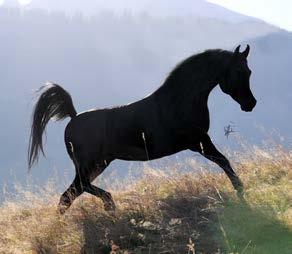
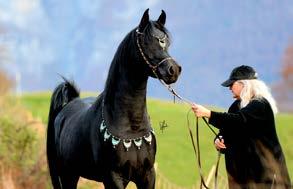

the homebred young mare Jumanah al Jabal Nile Pasha Halim (Ansata Nile Pharao x Nagda Halima)
The homebred young Rayyanah al Jabal
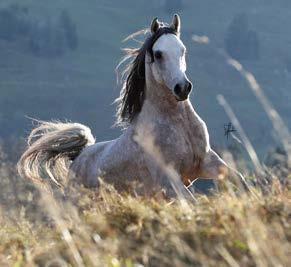
career as a broodmare next year, with the lovely Nile Pasha Halim (Ansata Nile Pharao x Nagda Halima). Two more almost four-years-old mares join the group of young mares at Al Jabal Arabians: Rayyanah al Jabal (Sharif Ibn Sheikh al Jabal x Layla Bint Ghazira al Jabal), and Masida Halima (Ansata Nile Pharao x Mabrouka Halima, a MaydanMadheen daughter). The true queen of Al Jabal, however, is the soon 24-year-old Fay Sabeena (Fay Sabun x Matala Bint Marah by Jamil), a Marah / EAO granddaughter and the last living Matala Bint Marah daughter. She is the most gentle and sweet mare and if she looks at you with her beautiful large black eye it feels like she was looking deep into your soul. With the addition of the black homozygous mare AR Yosreya (AR Shandiz x AR Sheykha Bint Maymoun) last year, I closed the gap to the beginnings of almost 30 years ago in an instant, as she is tracing back to exactly the same mare as Sher-Gall, my first ever straight Egyptian Horse. She will always stay here with me, as she is one of the few homozygous black Abayyans in Europe. Yosreya is now, in 2020, in foal from NK Abbas El Dine (NK Jamal El Dine x NK Asila), bred by Dr. Hans Nagel of Katharinenhof Stud. Abbas is very typey with a compact body, with lovely eyes, and I am proud of his heritage. He carries the El Din legacy and instils a lot of the famous “Nagel refinement” into my program.
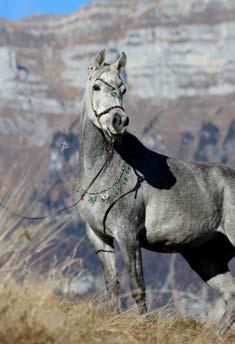

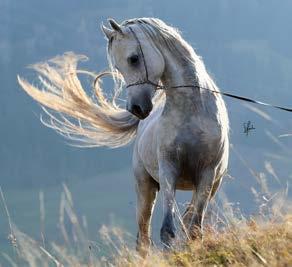
NK Abbas El Dine, bred by Dr. Nagel, Katharinenhof - chief sire of Al Jabal Arabians
Masida Halima, Maya’s precious Maydan-Madheen granddaughter
Monika: In your breeding, how important is type to you in relation to functionality?
Maya: My aim is to breed refined horses with good, solid bodies. It is just my type, I guess. I like horses that I can ride. None of my horses are garden ornaments. Once my babies are sufficiently grown up, I have them trained to be great future riding horses until I find a wonderful 5-star-home for one or the other. Functionality is just as important as type in my opinion, and I don’t breed mainstream show horses. That doesn’t mean that my homebred horses can’t be shown – but I don’t like the so-called industry with mostly horses who look all the same. I love individuality, I love being a bit different. So I prefer to attend shows like the Noble Straight Egyptian Breeders Festival, which Mahmoud Anzarouti initiated 2017. That’s an event that brings together breeders, Arabian Horse lovers, and enthusiasts from all over the world to present their Straight Egyptian breeding programs. These presentations are held in a relaxed and joyful atmosphere, without judgement but with a lot of passion. Most breeders will even present their horses themselves… something you rarely find at mainstream shows nowadays because they are all in the hands of professionals - which is not always an advantage for the horses. This is why I am proud to be a member of the Honorary Board of the Noble Festival and

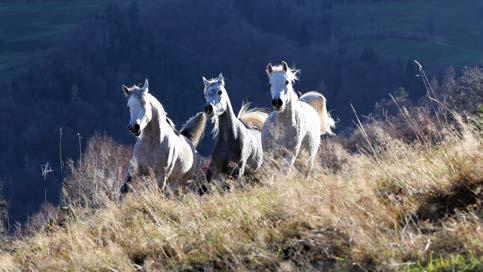
young mares of Al Jabal Arabians - Masida Halima, Rayyanah al Jabal and Jumanah al Jabal
strongly support this kind of event. I hope that similar initiatives for horse presentation will soon emerge in other countries as well. We did our successful first step already, which may serve as a model for others.
Monika: What about your new stallions on your farm?
Maya: I have added two very exciting boys of the Saklawi strain to my stallion barn: With Nabiel Halim, by Sabeh al Salhia and out of Nile Halima (a PVA Kariim daughter), it’s not only that I have a future sire with an excellent pedigree in my stable – with Nabiel Halim, I have a potential sire who will transmit the strong bodies that I like so much in my breeding. The second future sire of Al Jabal Arabians is DF Nafis, a homozygeous tested solid black colt sired by DF Siraj and out of DF Nadeemah by Miad al Shaqab. I adore his small typey ears and his big dark eyes, certainly a trait which is often difficult to find within black SEs. On top of all that he is a great mover and I love to do ground work with this smart young fellow. Both of them represent my hopes and dreams for the future of my breeding program, and I am very excited to have some of their progeny at Al Jabal Arabians soon. Not just to be able to see their foals’ hopefully top-quality appearance, but mainly to eventually know for sure if they are the sires who can advance my breeding program.
Monika: How to you plan to go on, living your life as a breeder up here in your alpine surroundings?
Maya: I have always chosen to do things „my way“ – I have to finance my horses myself, so I take the liberty to decide what I want and how I
Nabiel Halim, young Ansata Nile Echo grandson

Maya with her beloved stallion NK Abbas El Dine by NK Jamal El Dine
want it… no matter what other people might say. I am not using famous show stallions to breed with – I’m using the right ones for my mares and these may be “no name” stallions. Besides, I am convinced that embryo transfer on the massive scale that it was done, did damage to Arabian horse breeding overall. I don’t use embryo transfer at all. I want foals to grow up with their Arabian dams, benefiting from their Arabian character and their way of educating their foals. We need to put effort into improving the quality of the breed, not the quantity. I am glad I’m self-sufficient and independent, meaning I can take my decisions based on what’s in my horses’ best interests.
Like so many fellow breeders, I am strong, determined and passionate about what I believe in. And I have learned that even the smallest breeders, like myself, can be the backbone of the Arabian breed, especially during such difficult times as we are all going through right now. q
